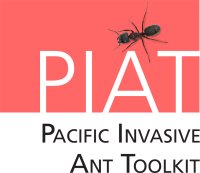Applying treatments
Before commencing treatment, make sure the community is fully informed about the work and health and safety concerns are addressed. Make sure any pre-treatment monitoring is done and environmental and social impact considerations have been addressed. Ensure all people undertaking management have been trained in treatment application.
Communication is important!
When undertaking treatment it is essential that all stakeholders are kept informed of what is happening. This will minimise the risk of health effects and will also make the operations go smoothly.
If the treatment is happening in an inhabited area, communication should include public meetings, school visits, warning posters in and around the treatment area, warning leaflets for each household and health surveys for each household.
Posters and leaflets should feature the following information:
- The name of the chemicals being used
- When it is being used (dates from to)
- A photograph of the bait(s)
- Safety instructions (do not touch bait, watch children at all times and keep them out of the area, do not eat animals from this area etc.)
- Contact details for further information
Health and safety
When handling and distributing pesticides, health and safety is the primary concern. EVERY chemical that is used for ant control will have an accompanying Safety Data Sheet (SDS). SDSs for all products are available online or you can request a copy from the supplier of the bait or pesticide you plan to use. Some basic rules of safe handling include:
- Always read the instructions before use
- Use gloves when handling products (check the SDS for details of which type of gloves offer the best protection and other personal protection recommendations)
- Do not eat, drink or smoke whilst handling pesticides
- Always wash your hands after using any chemicals
- Avoid breathing any vapours or dust - wear appropriate respiratory protection if necessary
- Store all insecticides in a secure place away from children and animals
- Ensure all stakeholders are made aware of any risks associated with insecticide use
Treatment application
Instructions on the use of granular baits, targeted insecticides, paste and gel baits, bait stations and nest injection are provided here. We show you details of how to measure and spread bait efficiently, how to look for non-target effects and case studies of ant management programmes that have been successfully undertaken in a variety of environments.
Treatment products can be obtained from a number of suppliers.
Ant baits are expensive and can have non-target effects on the environment. For these reasons it is important to distribute the correct amount of bait in the right way - too little and you will not achieve your goals, too much and the bait will remain in the environment where it might poison beneficial organisms or contaminate ground water. Also use the correct treatment for your target species and environment.
When applying any insecticide or other bait it is essential that you:
We have created a video that outlines the methods of application for the three main manual treatment options: granular broadcast baits, bait paste and residual sprays. The video is also available in French. |
Treatment methods for ants, YouTube video. The video is also available in French (© PIAT, Pacific Biosecurity) |
content reviewed by Viv van Dyk, FBA Consulting, July 2017
